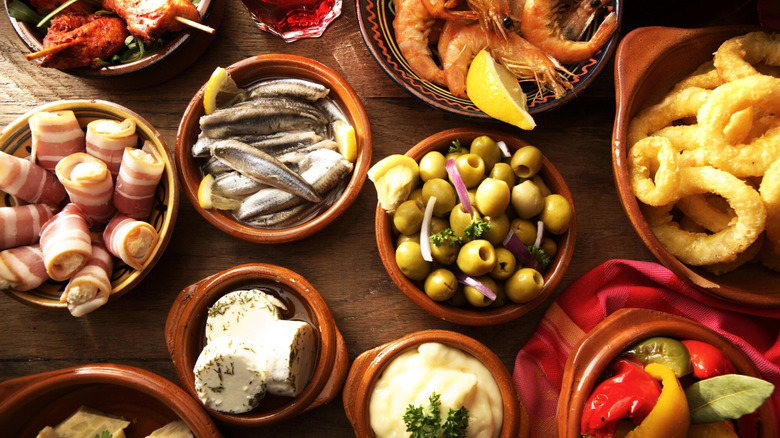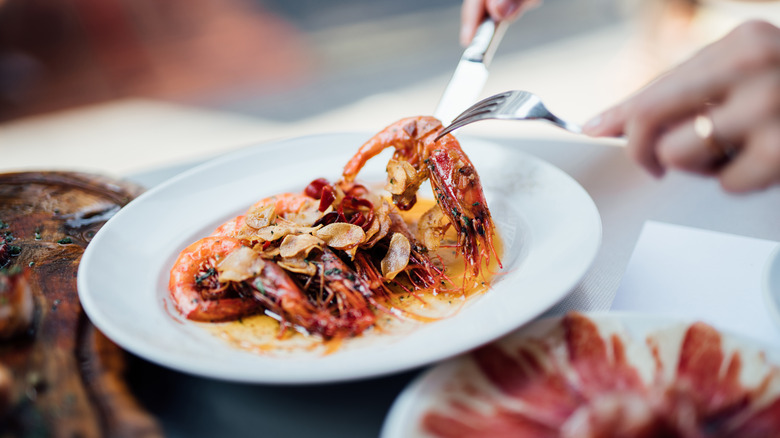Do You Know The Difference Between Pintxos And Tapas?
In America, you might get a bowl of peanuts or salted pretzels offered to you when you order a drink at a casual bar. In Italy, friends gather before dinner for aperitivo, where they order drinks and cocktails; often accompanied by small bowls of snacks like almonds, olives, and potato chips. In France, the practice is called apero, where drinks may come with similar snacks. And in Spain, the tradition of tapas (which is basically small plates of food) is widely renowned. In many of these cases, the food is complimentary when you order a drink.
Tapas have become so popular in the West that you can now find tapas bars in many countries outside of Spain. Less prevalent are pintxos (pronounced "peen-chos"), which are also associated with Spain, however, they aren't nearly as widespread, even if they do look very much like something you might find in a tapas bar.
What are tapas?
Throughout the sun-drenched country of Spain, tapas bars are common, although some regions are more saturated than others. Tapas can be hot or cold dishes and have traditionally been offered free to patrons who order drinks. As tapas have grown in popularity, some tapas bars have begun to charge a fee for them; it's always best to ask if there is a cost for these dishes before you partake. Tapas means "to cover," which refers to early tapas, which were slices of bread that customers would lay on top of their wine glasses to keep flies away.
The variety of tapas in Spain varies tremendously throughout the Mediterranean country. For instance, if you're in the coastal cities of Barcelona or Valencia, you're much more likely to be offered a seafood-based dish than you would if you were in the middle of the country. Still, there are certain tapas popular throughout Spain, including mixed olives, meatballs, slices of jamon, fried squid, slices of chorizo (an international sausage you should try at least once), slices of tortilla (in Spain, this is an egg-based dish, similar to an omelet), patatas bravas (fried potatoes), and shrimp in garlic oil. Many times, patrons who order drinks will automatically be given whatever tapas the house is serving up that day, but occasionally, customers will be given a menu to choose their preference.
What are pintxos?
Pintxos (aka pinchos) are more common in Northern Spain, specifically Basque country, where they're said to have originated. Basque country encompasses four regions in Spain and three in France. One of the most lauded elements of Basque country is its cuisine, which includes pintxos. Whereas tapas can sometimes verge on a full meal, pintxos are small snacks whose ingredients are traditionally placed on top of bread and held together with a toothpick . They are often presented on a table for customers to help themselves. Once finished, guests keep their toothpicks so the bartender can count how many pintxos have been eaten and charge accordingly. This is one way pintxos differ from tapas: they aren't free.
Like tapas, pintxos come in countless forms made with various ingredients. One of the most popular pintxos in Spain is tomato bread with manchego cheese. A mixture of freshly grated tomato and garlic is spread on a slice of baguette and topped with a thin slice of Manchego cheese which is held in place with a toothpick. A tuna and anchovy pintxo is made by piling canned tuna in oil (Ortiz brand is a great choice) on a piece of bread along with strips of roasted red pepper, an anchovy filet, and a Spanish green olive on top. Spinach tortilla with roasted red pepper is another popular dish, as are Spanish potato salad and shrimp sauteed in garlic oil and smoked paprika. With both tapas and pintxos, popular beverage choices include beer, wine, sherry, and tinto de verano (a refreshing mixture of red wine and lemon lime soda).


